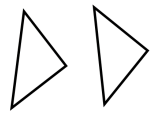General Information
Benchmark Instructional Guide
Connecting Benchmarks/Horizontal Alignment
- There are no direct connections outside of this standard; however, teachers are encouraged to find possible indirect connections.
Terms from the K-12 Glossary
- Composite Figures
- Rectangles
- Squares
- Triangle
Vertical Alignment
Previous Benchmarks
Next Benchmarks
Purpose and Instructional Strategies
The purpose of this benchmark is to allow students opportunities to discover further connections and patterns with two-dimensional figures. Students should have an opportunity to investigate combining figures in a variety of sizes and orientations (MTR.2.1, MTR.5.1).- Instruction includes composite figures that may be named based on previous benchmarks,
as well as those not included in previous benchmarks, though there is no expectation of a
formal name for new composite shapes outside of previously named figures.
- For example, a triangle and square forming a pentagon, may not need to be formally identified as a pentagon. Two triangles that form a rectangle can be formally identified as a rectangle.
- Exploring with figures of different sizes and orientations allows students to continue to develop an understanding of spatial reasoning (MTR.2.1).
Common Misconceptions or Errors
- Students may attempt to compose figures without regard to aligning sides or vertices. The overlap may cause difficulty in naming or describing the new composite figures.
- Students may avoid lining the edges of two figures if the sides aren’t the same length.
- For example, it could be appropriate to join several rectangles of various sizes to make a figure that looks like a building with towers.
Strategies to Support Tiered Instruction
- Instruction includes providing opportunities to compose shapes using pattern blocks.
Begin by having students compose rectangles using squares.
- Example:
-1.png)
- Teacher provides pattern block fill-in puzzles and has students join shapes together to compose new shapes using triangles, rectangles and squares.
Instructional Tasks
Instructional Task 1 (MTR.2.1, MTR.4.1, MTR.5.1, MTR.7.1)
Provide each student in a group or whole class with a plethora of rectangles, squares and triangles in a variety of shapes and sizes (be intentional in assuring that various sides are congruent for the purpose of composing new figures). Ask students, “can you make a new figure using two of the figures I have given you?” Give students time to explore, then opportunities to share. Record the findings, focusing on what may be considered “key” compositions (two squares making a rectangle, two triangles making a rectangle, a “house” from a rectangle and triangle, or an octagon from triangles).
Instructional Items
Instructional Item 1
Jamie says that you cannot make a rectangle using the 2 triangles below. Is she correct? Justify your answer.
*The strategies, tasks and items included in the B1G-M are examples and should not be considered comprehensive.
